-

人教版新目标初中英语八年级下册He said I was hard-working教案2篇
This activity introduces some new vocabulary and provide oral practice using the target language.Task 1 . Ask four students to stand in front of the class, and the teacher asks them the following questions as a reporter.1.What are you going to do when you grow up?2.What are you going to do next week?3.What are going to do after school?The students will give different answers, then ask a good student to report what they said.I am going to e a doctor.What did she say?----------She said she was going to be a doctor.I am going to have a party on Friday night.What did he say?-------He said he was going to have a party on Friday night.I am going to do my homework.What did she say ?------ She said she was going to do her homework.I am going home after school.What did she say?-----She said she was going home after school.Say In this unit we are going to learn to use words like to report what someone said.Task 2. Read the instructions. Then ask a student to read the four questions. And write the words on the Bb. Explain what soap opera is.Task 3. Ask the students to Look at the pictures, point out the TV screens in the picture. Ask one girl to read what Marcia said.What did Marcia say? She said She said she was having a surprise party for Lana on Friday night. Repeat the other pictures in the same way.Activity3. Listen and number the pictures in activity 1a.

人教版新目标初中英语八年级下册How long have you been collecting shells教案2篇
Step Ⅱ Show the new words on the screen and teach the new words. Read the new words to students and ask them to repeat.Step Ⅲ 3aThis activity introduces new vocabulary and provides reading practice using the target language.In this activity first look at the four pictures.T: What can you see in the pictures?Ss: Four snow globes.T: Right. There are four snow globes in the pictures. And what are they?Ss: They are a monster, two polar bears, two penguins and a birthday cake.Write these words on the blackboard: snow globe; monster; polar bear; penguin and birthday cake. Read them to the class and ask students to repeat each one. Make sure students understand each word.Use a computer to show the E-mail message on the screen and read the message to students.Get students to read the e-mail on their own, and then draw lines connecting each snow globe and its description.Correct the answers.AnswersA line should connect each snow globe picture with the words that describe it in the letter.Step Ⅳ 3bThis activity provides writing practice using the target language.First review Activity 2a on Page 47.Then ask students to complete the message according to Activity 2a.Some partial sentences are given to students. Write about one person's collection.When students work, walk around the room checking the progress and offering help as needed.When they finish, ask some students to read their messages to the class.

人教版新目标初中英语八年级下册What were you doing when the UFO arrived教案2篇
(一).知识方面: 1.培养学生能运用过去进行时来描述、谈论过去某个时间正在发生的事情或动作的意识和能力,能就过去某个时间正在发生的动作做出正确的描述。 2.培养学生的想象力和角色扮演的合作能力。 3.培养学生讲述过去发生的事情经过的能力。能正确运用一般过去时来讲述故事。 (二).技能方面: 1.本单元的语言目标是Talk about past events and tell a story(谈论过去的时间和讲述一个故事),围绕这一目标,要涉及句型: What were you doing when the UFO arrived? ----I was sitting in the barber’s chair. The barber was cutting my hair. 因此必须学习standing、studying、cleaning、sleeping、cooking、making、eating、cutting、等表示地点的词,以便为上述句型提供语言材料。2.学习过去进行时的有关知识。Was/were+现在分词,是该时态的表达式。 3.在学习过程中,要区分The boy was walking down the street when the UFO landed.和While the boy was walking down the street, the UFO landed.这两种由when和while引导的状语从句的句型结构。注意它们的不同。

人教版新目标初中英语八年级下册Why don’t you get her a scarf教案
教师带领学生复习有关描述宠物的词汇,采用教师提问学生回答的方进行。如:T:What animals do you think would be good pets?What animals do you think would be bad pets?What do you think are good animals for a six-year-old child?然后学生进行 pairwork 练习。Task two: 师生互动,学习探究 1、播放3a部分的录音,引导学生一边听录音,一边跟读。2、通过听录音学生回答以下问题:Why do you think pot-bellied pigs are popular?What are the advantages and disadvantages of keeping such a pet?教师对学生的回答进行及时点评。3.学习范文,学习重点短语,为下步的模仿写作提供语言素材。T :1. )Have you ever kept a pig as a pet?Do you like pigs? St.:No.…Why don’t you like to keep a pig? St: No.They’re too dirty and lazy(Do you know in some foreign countries like Hollyland, Australia,pigs are the most popular pet.there’s a kind of pig.(图)it has an interesting name? it ‘s called a pot-bellied pig.) Now,let’s learn an article about this kind of interesting pet.2.)play the tapeSt.:Listen and repeat3.)show some Qs on computer(本子St.: read silently,then answerthe Qs(本子)4.)Ask ss. Close book and retell this passage.(what is a pot-bellied pig? Is it a good or bad pet? ) St.: retell it to each other“A pot –bellied pig is a popular pet now…”5.read the article together.St.:.practice reading

人教版新目标初中英语八年级下册Would you mind turning down the music教案
Step 4. Group work (4)1. Ask a pair of students to read the dialogue. Say, This activity provides speaking, listening and writing practice using the target language.2. Ask students to complete the work in groups.3. Check the answers with the whole class. 4. Explain some of the language points. Step 5. Word review (Self check 1)1. Ask students to read the words and the phrases given. 2. Fill in the blanks with proper forms of these words to complete the sentences. 3. Check the answers with the whole class. Homework:Do activity 2 on page 57 after class. Period 6Teaching aims: 1. Teach vocabulary words and the useful expressions. 2. Enable the students to learn etiquette in different culture. 3. Help the students learn how to behave politely in public places and in daily life. Teaching procedures:Step 1. RevisionHelp students to review the function of making requests through a free talk. Then lead them to the topic of etiquette. Explain the meaning of etiquette. Or, ask students to look it up in the dictionary. Step 2. Pre-reading (Section 1)1. Ask students to read the picture and make a list with their partner about how many rules of etiquette can be seen being broken.

人教版新目标初中英语九年级上册I like music that I can dance to教案
教学目标: 1. Express preferences2. Talk about one’s likes and dislikes and the reasons3. Learn to express one’s opinions 4. Learn to write a reply 语言功能: 1) Talk about one’s preferences, using t he relative clause2) Talk about people’s likes and dislikes and the reasons3) Talk about opinions语言结构: Relative clauses with that and who语言目标:What kind of music do you like?I like music that I can sing along with.I love singers who write their own music.We prefer music that has great lyric.重点词汇及短语:heart, photography, interest, class, whatever, miss, okay, expect, sweet, taste, itself, laboratory, cancer, increase, biscuit, main, care, prefer… to…, remind somebody of …, dance to, sing along with, be sure to, interest somebody, make somebody adj., to be honest, suit somebody, on display, catch up教学重难点:What do other people think of the different kinds of things? How to express one’s opinions? 学习方式:讨论,合作学习情感目标:通过本单元的学习,能提高学生的艺术鉴赏能力和审美情趣,并引导学生养成健康的饮食习惯。课时安排5课时第一课时:Section A: 1a-2c第二课时:Section A : 3a-4第三课时:Section B:1-2c, Self check2第四课时:Section B: 3a-4, Self check1第五课时:Self check ReadingI like music that I can dance to.

人教版新目标初中英语九年级上册How do you study for a test教案2篇
内容提示本单元主要内容是学会利用verb十by/with gerund表示方式方法来讨论学习英语的策略,认识自己在学习方面的长处和不足。初步了解现在完成时的结构和用法。现在完成时由助动词have/has+动词的过去分词构成,主要表示过去发生的某一动作对现在仍有影响或造成的后果,常与already,yet,just,ever,never等副词连用。教学目标一、学习目标(Language Goal) 1. Talk about how to study . 学会讨论各种学习方法和策略。2. Find out your suitable learning methods. 找出适合自己的学习方法。 二、语言结构(Language Structures) 1. Verb + by with gerund by+动名词短语 表示“通过…途径,方法” 2. How questions have引导的特殊疑问句 三、目标语言(Target Language) 1. How do you study for tests ? 你是怎样准备考试的?Well , I study by working with my classmates. 哦,我和同学们一起学习。2. Have you ever studied with a group ? 你曾经参加过学习小组吗?Yes , I have . I’ve learned a lot that way . 是的,参加过。通过这种方式我学了许多。

人教版新目标初中英语九年级下册By the time I got outside, the bus had already left教案
Ⅰ. Teaching Aims and Demands1. Knowledge Objects(1) Key Vocabularyoversleep(2) Target LanguageWhat happened?I overslept. And by the time I got up, my brother had already gotten in the shower.2. Ability Objects(1) Teach the students to use the new words.(2) Train the students to narrate past events with the Past Perfect Tense.(3) Train the students' listening and speaking skills with the target language.3. Moral ObjectIt’s a good habit to go to bed early in the evening and get up early in the morning. So you’ll never be in a hurry in the morning.Ⅱ. Teaching Key Points1. Key Vocabularyoversleep2. Target LanguageNarrate past events with the Past Perfect TenseⅢ. Teaching Difficult Points1. Train the students to narrate past events with the Past Perfect Tense.2. Train the students to understand the target language in spoken conversation.Ⅳ. Teaching Methods1. Thinking of examples from the students' real lives.2. Making sentences by looking at the pictures.Ⅴ. Teaching AidA tape recorderⅥ. Teaching ProceduresStep I Revision1. Revise the language points in Unit 8.Ask some questions like this: What volunteer work would you like to do?Help the students to answer, I’d like to…/I love to…/I hope to2. Practice the dialogue in Activity 3c on page 62 again. Get students to role play the similar dialogues with the following.

人教版新目标初中英语九年级上册Where would you like to visit教案2篇
The First PeriodⅠ.Teaching Aims and DemandsKnowledge Objects(1) Key Vocabularytiring, educational, fascinating, thrilling, peaceful, exotic, trek, jungle, take it easy, explore, historic, site(2) Target LanguageWhere would you like to go on vacation?I’d like to trek through the jungle, because I like exciting vacations.2. Ability Objects(1)Train students to talk about places they would like to visit with the target language.(2)Train students to describe vacations with different adjectives.(3)Train students' listening skill.3. Moral Object,It′s more interesting to go on vacating somewhere instead of staying at home.Ⅱ. Teaching Key Points1. Key Vocabularytiring, educational, fascinating, thrilling, peaceful, exotic, trek, jungle, take it easy, explore, historic, site2. Target LanguageTalk about different places with the target language.Ⅲ. Teaching Difficult Points1. Describe vacations with different adjectives.2. Talk about different places with the target language.Ⅳ. Teaching Methods1. Teaching by illumination2. Teaching by doing chain drills3. Teaching by pairworkⅤ. Teaching Aids1. A tape recorder2. Some pictures of different places with famous views

人教版新目标初中英语九年级下册Could you please tell me where the restrooms are教案
Step Ⅰ RevisionCheck homework. Ask a few students to read the article in 3a.Then ask a few students to read their guides.Step Ⅱ Part 1Look at the words in the box. Ask a student to read them. Make sure the students understand the meaning of the words. You are to fill in the blanks with the words. In some cases, students may need to use another form of the word, for example adjusting for tense or subject/ verb agreement.Ask students to fill in the blanks on their own.Check the answers. Step ⅢPart 2Go through the instructions with the class.Look at the example with the students.Ask students what the answer would be.Ask a student to read the question and answer it.Excuse me, could you tell me where the bank is, please?The bank is across the street from the shopping malt.Get students to complete the work in pairs.Check the answers. Ask a few students to read their questions.Step Ⅳ Just for Fun!Ask all the students to read the conversation. Ask: What is funny about this cartoon? Help students to explain. A Martian is a person from the planet Mars.There is no such thing as Martian food on Earth, and the clerk looks silly because he is trying to think of where there is a Martian restaurant.Invite some pairs of students to present this conversation to the rest of the class.Step Ⅴ Summary and HomeworkIn this class, we’ve done much writing practice using the key vocabulary words and the target language presented in this unit. After class, please finish the questions in 2 in your exercise books. Then finish the exercises on pages 47~48 of the workbook as well.The Seventh Period Ⅰ Teaching Aims and Demands1. Knowledge Objects(1) Key Vocabularyimage, adventure, jealousy, hero, crime, journey, brave, no longer, show interest in, take it easy, become interested in, plain looks(2)Text:Grown-ups like cartoons, too.2. Ability Objects(1) Fast-reading to get a general idea of the text.(2) Careful-reading to get the detailed information in the text.

人教版新目标初中英语九年级下册We’re trying to save the manatees教案2篇
本单元主要围绕着有关濒临灭绝的动物这一话题,学习了应该怎样保护我们的环境,以及就某一问题展开辩论。目标提示语言目标能够运用所学知识,就某一问题展开辩论。认知目标1、复习一些语法:现在进行时、一般现在时、用used to 表示一般过去时、现在完成时、一般过去时的被动语态。2、学会表达同意和不同意。3、学会以下基本句型:We’re trying to save the manatees.Manatees eat about 100 pounds of food a day.There used to be a lot of manatees.In 1972,it was discovered that they were endangered.Some of the swamps have become polluted.情感目标了解一些濒临灭绝的动物的生活习性和濒临灭绝的原因,教育学生应该如何保护环境。教学提示充分利用多媒体等教学设备,创设与本课话题相关的情境,如各种不同种类的动物、动物园以及有关环境的画画等等。围绕着本单元的教学目标,设计一些贴近学生实际的教学任务,如让学生谈论自己最喜欢的动物,如何拯救濒危动物,如何保护环境等等。让学生根据所学知识,就动物园是否对动物有利以及其他的话题进行辩论。
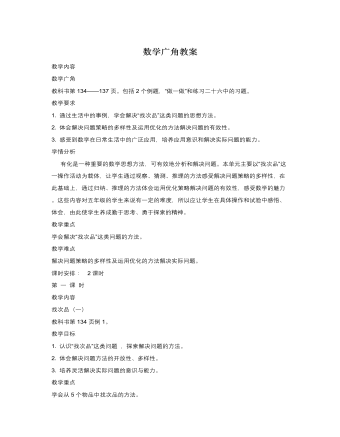
人教版新课标小学数学五年级下册数学广角教案
教学要求1. 通过生活中的事例,学会解决“找次品”这类问题的思想方法。2. 体会解决问题策略的多样性及运用优化的方法解决问题的有效性。3. 感受到数学在日常生活中的广泛应用,培养应用意识和解决实际问题的能力。学情分析有化是一种重要的数学思想方法,可有效地分析和解决问题。本单元主要以“找次品”这一操作活动为载体,让学生通过观察、猜测、推理的方法感受解决问题策略的多样性,在此基础上,通过归纳、推理的方法体会运用优化策略解决问题的有效性,感受数学的魅力。这些内容对五年级的学生来说有一定的难度,所以应让学生在具体操作和试验中感悟、体会,由此使学生养成勤于思考、勇于探索的精神。教学重点学会解决“找次品”这类问题的方法。
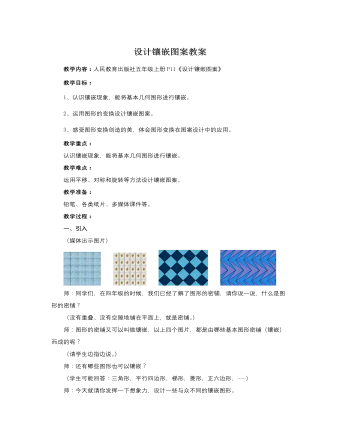
人教版新课标小学数学五年级下册设计镶嵌图案教案
师:同学们,在四年级的时候,我们已经了解了图形的密铺,请你说一说,什么是图形的密铺?(没有重叠、没有空隙地铺在平面上,就是密铺。)师:图形的密铺又可以叫做镶嵌,以上四个图片,都是由哪些基本图形密铺(镶嵌)而成的呢?(请学生边指边说。)师:还有哪些图形也可以镶嵌?(学生可能回答:三角形,平行四边形,梯形,菱形,正六边形,……)师:今天就请你发挥一下想象力,设计一些与众不同的镶嵌图形。[设计意图说明:学生在四年级已经初步了解了图形的密铺(镶嵌)现象,四幅图片是四年级下册教材《三角形》单元中《密铺》内容中的原图。本单元在此基础上,通过数学游戏拓展镶嵌图形的范围,让学生用图形变换设计镶嵌图案,进一步感受图形变换带来的美感以及在生活中的应用。]二、新授探究一:利用平移变换设计镶嵌图形
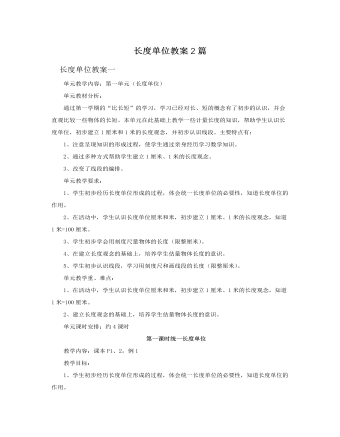
人教版新课标小学数学二年级上册长度单位教案2篇
l尺子上每相邻的两条长刻度线之间的一大格的长度都是1厘米。师:我们大家现在一起用手比划一下,1厘米多长。互相看一下,计住了吗?闭上眼睛想一想,1厘米有多长。3、认识几厘米师:我们现在知道1厘米有多长了,那3厘米又有多长呢?师:同学们还能在尺子上找到其他3厘米的长度吗?4、用厘米量师:刚才上课时,老师展示的2根线绳,到底哪一根长一点呢?现在,同学们先估计一下这两根线绳各自多长,然后在测量比较一下,好吗?师:结果是哪根线绳长一点呢?能说说你是怎么量的吗?三、知识拓展1、师:老师这里有一把尺子,可是它断了一节,没有刻度“0”,只剩下刻度3到刻度10,那么这把尺子能不能用来量物体的长度啊?同学们能不能帮老师想一想办法,好吗?2、其他测量长度的工具(课件展示)
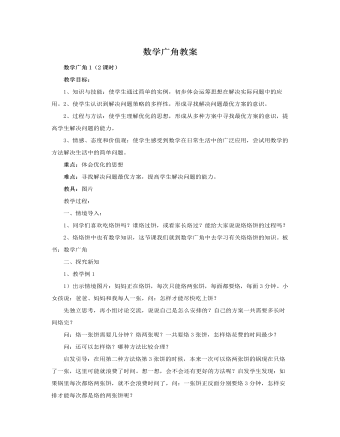
人教版新课标小学数学四年级上册数学广角教案
教学目标:知识与技能:1、使学生初步体会对策论方法在解决实际问题中的应用。2使学生认识到解决问题策略的多样性,形成寻找解决问题最优方案的意识。3、培养学生的应用意识和解决实际问题的能力。过程与方法:使学生理解优化的思想,形成从多种方案中寻找最优方案的意识,提高学生解决问题的能力。情感、态度和价值观:使学生感受到数学在日常生活中的广泛应用,尝试用数学的方法解决生活中的简单问题。重点:体会优化的思想难点:寻找解决问题最优方案,提高学生解决问题的能力。教具:图片教学过程:一、情境导入:1、你们听过“田忌赛马“的故事吗?田忌是怎样赢了齐王的?谁能给大家讲一讲这个故事?2、问:田忌的马都不如齐王的马,但他却赢了?这是为什么呢?3、这节课我们就来研究研究。板书课题:数学广角
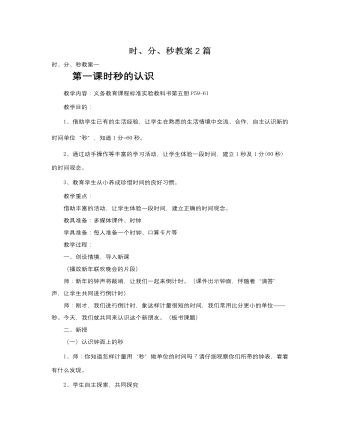
人教版新课标小学数学三年级上册时、分、秒教案2篇
教学目的:1、通过贴近学生生活实际的素材,在丰富多彩的实践活动中充分体会时、分、秒的实际意义。2、通过练习,学生比较熟练地进行一些简单的时间计算教学重、难点:时间单位的简单转换和求经过时间的方法。教学过程:第2题,先让学生独立完成,再让学生说一说每一题是怎么比较的,允许学生用不同的方法进行比较,只要说得有道理就行。第3题,读读书上的三个例子,并要求学生收集类似的信息。第4、5题,学生计算经过的时间。如果部分学生有困难,让他们借助钟面模型加以演示、理解,教师给予适当的帮助。第6题,要求学生先估计,再实际进行验证,验证的数据可以由学生和家长一起完成。第7题,事先让学生找几个自己感兴趣的节目,想办法把它们开始和结束的时刻都记录下来。
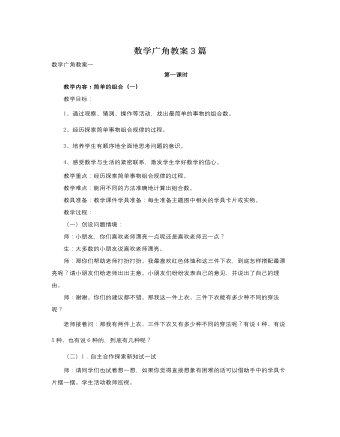
人教版新课标小学数学三年级上册数学广角教案3篇
(一)创设问题情境:师:小朋友,你们喜欢老师漂亮一点呢还是喜欢老师丑一点?生:大多数的小朋友说喜欢老师漂亮。师:那你们帮助老师打扮打扮。我最喜欢红色体恤和这三件下衣,到底怎样搭配最漂亮呢?请小朋友们给老师出出主意。小朋友们纷纷发表自己的意见,并说出了自己的理由。师:谢谢。你们的建议都不错。那我这一件上衣、三件下衣能有多少种不同的穿法呢?老师接着问:那我有两件上衣、三件下衣又有多少种不同的穿法呢?有说4种、有说5种、也有说6种的,到底有几种呢?(二)1.自主合作探索新知试一试师:请同学们也试着想一想,如果你觉得直接想象有困难的话可以借助手中的学具卡片摆一摆。学生活动教师巡视。2.发现问题学生汇报所写个数,教师根据巡视的情况重点展示几份,引导学生发现问题:有的重复了,有的漏写了。
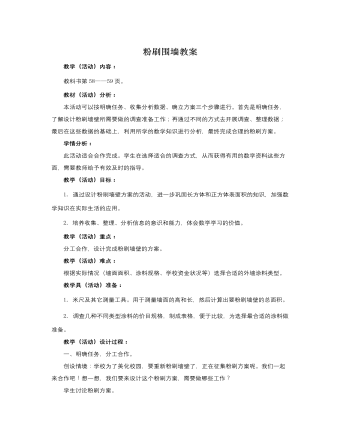
人教版新课标小学数学五年级下册粉刷围墙教案
(3)按每千克涂料粉刷3.5 m2计算,可求出共需要涂料:1600÷3.5≈460(千克);(4)根据涂料的型号及费用,选择合适的涂料。师:选择涂料时,要考虑很多因素,如价格、耐用期、消费心理、环保等,要怎么选择呢?学生可以把几种涂料进行对比,一起讨论决定,同时学会在交流中理解接纳别人较好的建议:如:A型,优点:价格便宜,需要19桶,总共才5700元;缺点:耐用期太短,两年后又要重新粉刷;B-1型和B-2型,虽然桶装量不同,但价格和耐用期都处在中游水平;C型和D型,优点:耐用期长,最划算;缺点:价格太高,不符合人们的消费心理,也不可能持续那么长时间,至少5年就要更换一下样子。综合以上价格、耐用期、消费心理,选择B-1或B-2型比较划算。而这两种比较来看,B-2型更便宜一些,所以,最后确立用B-2型涂料。
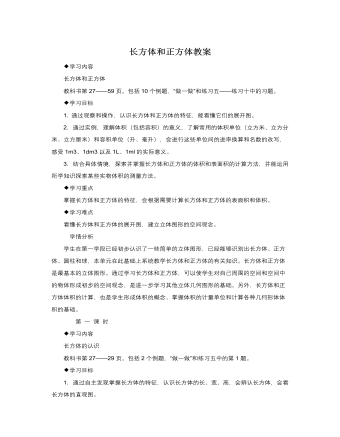
人教版新课标小学数学五年级下册长方体和正方体教案
◆学习内容长方体和正方体的体积教科书第40——43页例1、例2,第43页“做一做”,以及练习七第3——8题。◆学习目标1. 掌握长方体和正方体的体积计算公式,学会计算长方体和正方体的体积。2. 培养实际操作能力,推理能力及运用知识解决实际问题的能力。◆学习重点能正确计算长方体和正方体的体积。长方体和正方体体积的计算是形成体积的概念、掌握体积的计量单位和计算各种几何形体体积的基础。◆学习难点理解长方体和正方体的体积计算公式的推导过程。体积公式的推导是建立在充分的感性经验的基础上,沟通每行个数、行数、层数与长、宽、高之间的联系,进而顺理成章地推导出公式。◆学习过程1. 实验探索长方体的体积公式计量一个长方体的体积是多少,就是看这个长方体里含有多少个体积单位。但不是所有的物体都能切割成若干个小正方体。动手做试验:用体积为1cm3小正方体摆成不同的长方体。将相关数据填入下表。
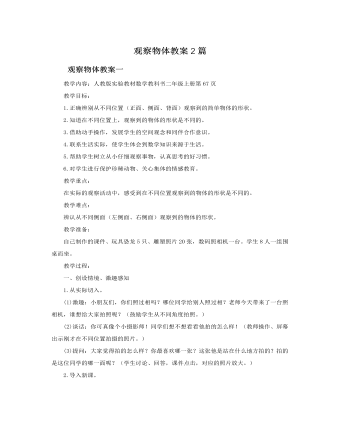
人教版新课标小学数学二年级上册观察物体教案2篇
教学过程:一、故事导入1.出示主题图配合音乐,师:“有一只蜻蜓在动物城里玩,遇到了辛勤工作的蜜蜂,看见了一座座漂亮的房屋。”蝴蝶说:“瞧。自己做了一件衣服,但是穿起来很不合身,怎么办?”(出现三种不对称的衣服图形)“于是,蝴蝶去找蜻蜓帮忙。”2.师:“一路上,蝴蝶看到许多美丽的景色,遇见许多动物朋友。瞧,美丽的孔雀走来了,还有知了、七星瓢虫、螃蟹。”3.师:“小朋友,它们美吗?你能说说你觉得它们哪儿美?(学生自由回答)那咱们把它们画下来,好吗?”二、初步感知对称图形的特点1.(指着蝴蝶形)师:“这么美的图形你想不想剪出一个来?请小朋友们拿出一张彩纸,用剪刀剪出这只蝴蝶,行吗?”(请学生说一说怎么剪的?)师:“有的小朋友剪出的蝴蝶为什么不像呢?为什么有的小朋友又能剪出美丽的蝴蝶呢?蝴蝶的形状到底有什么特点,让咱们来研究研究。”

